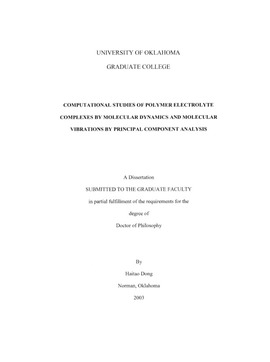| dc.contributor.author | Dong, Haitao. | en_US |
| dc.date.accessioned | 2013-08-16T12:19:08Z | |
| dc.date.available | 2013-08-16T12:19:08Z | |
| dc.date.issued | 2003 | en_US |
| dc.identifier.uri | https://hdl.handle.net/11244/658 | |
| dc.description.abstract | The second part (Chapter 4 and 5) focuses on computing vibrational frequencies and modes by using a new technique, principal component analysis (PCA) which is broadly used in signal processing, pattern recognition, and multivariate analysis. The advantages of PCA to incorporate anharmonicity in the calculated spectra over the conventional normal mode analysis and Fourier transform are presented in Chapter 4. PCA-derived frequencies of harmonic, anharmonic (with a quartic term in the potential energy), and Langevin oscillators and water molecules are more accurate than the frequencies calculated by normal mode analysis and Fourier transforms, in comparison with analytical or experimental results. New procedures in order to improve the PCA method including the determination of the vibrational energy, removal of the translations and rotations from the trajectories, and the treatment of flexible molecules based on fragments are proposed. More test cases of water, methane, water dimer, and ethane are provided to show that the frequencies are greatly improved by applying these new procedures in addition to the original PCA method. The last chapter is a demonstration of one of PCA's abilities to study molecular vibrational problems. (Abstract shortened by UMI.) | en_US |
| dc.description.abstract | The first three chapters of this dissertation are concerned with the structural properties of solid polymer electrolyte systems. Model polymers of poly(ethylene oxide) (PEO) and poly(ethylenimine) (PEI) containing four repeat units were studied by using molecular dynamics simulations. The chain dimensions, dihedral angle distributions, triad conformations were analyzed for PEO, PEI, and PEO:salt systems. The special ability of PEI chains to form two kinds of intra-chain hydrogen bonding, the single and double hydrogen bonding, makes the conformations of PEI chains more compact than PEO chains. The structural properties of PEO:LiCF3SO3 (lithium triflate) and PEO:NaCF3SO3 (having an ether oxygen: salt ratio of 10:1) complexes including the effects of oxygen-salt coordination on the polymer conformations and the ionic aggregation were also analyzed. The results show that the PEO chains contribute fewer oxygens (1.6 to Li+ and 2.2 to Na+ at 300K) to the cations than the triflate ions (4.6 and 4.9) and high temperature weakens PEO chain-cation coordination further. The species and the populations of different ionic aggregates calculated from MD simulations agree well with experimental values. All the results will help the understanding of ionic conductivity mechanisms in polymers. | en_US |
| dc.format.extent | xvi, 207 leaves : | en_US |
| dc.subject | Principal components analysis. | en_US |
| dc.subject | Polyethylene oxide. | en_US |
| dc.subject | Polyelectrolytes. | en_US |
| dc.subject | Chemistry, Physical. | en_US |
| dc.title | Computational studies of polymer electrolyte complexes by molecular dynamics and molecular vibrations by principal component analysis. | en_US |
| dc.type | Thesis | en_US |
| dc.thesis.degree | Ph.D. | en_US |
| dc.thesis.degreeDiscipline | Department of Chemistry and Biochemistry | en_US |
| dc.note | Source: Dissertation Abstracts International, Volume: 64-10, Section: B, page: 4959. | en_US |
| ou.identifier | (UMI)AAI3109053 | en_US |
| ou.group | College of Arts and Sciences::Department of Chemistry and Biochemistry | |
